Financial Markets and Institutions: RBA's Monetary Policy Analysis
VerifiedAdded on 2023/06/15
|9
|3252
|90
Report
AI Summary
This report examines the role of the Reserve Bank of Australia (RBA) in conducting monetary policy and its effects on Australian financial markets. It discusses the RBA's objectives, including price stability, full employment, and economic welfare, achieved through an inflation target of 2-3%. The report details the RBA's use of domestic market operations to manage the cash rate and influence interest rates. It also analyzes Australia's economic environment, focusing on inflation, interest rates, and the impact of monetary policy on asset prices, investments, and exchange rates. The importance of leverage in financial stability, particularly in relation to property, is highlighted, along with the risk management strategies employed by Authorised Deposit Institutions (ADIs) to address credit, liquidity, operational, and interest rate risks. Finally, the report touches on the role of Basel Accords in providing banking regulations for capital and risk management. Desklib offers a variety of resources, including past papers and solved assignments, to aid students in their studies.
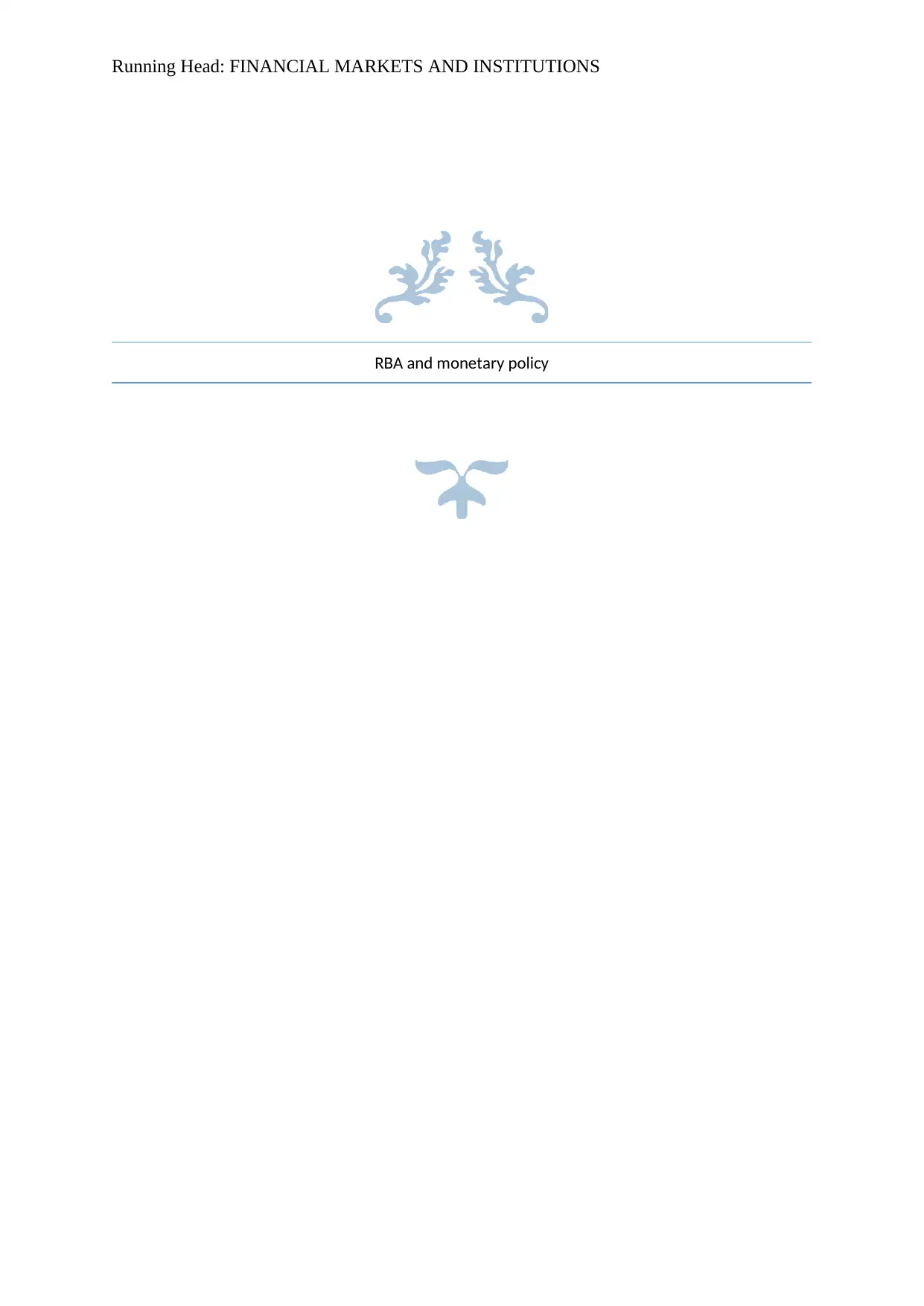
Running Head: FINANCIAL MARKETS AND INSTITUTIONS
RBA and monetary policy
RBA and monetary policy
Paraphrase This Document
Need a fresh take? Get an instant paraphrase of this document with our AI Paraphraser
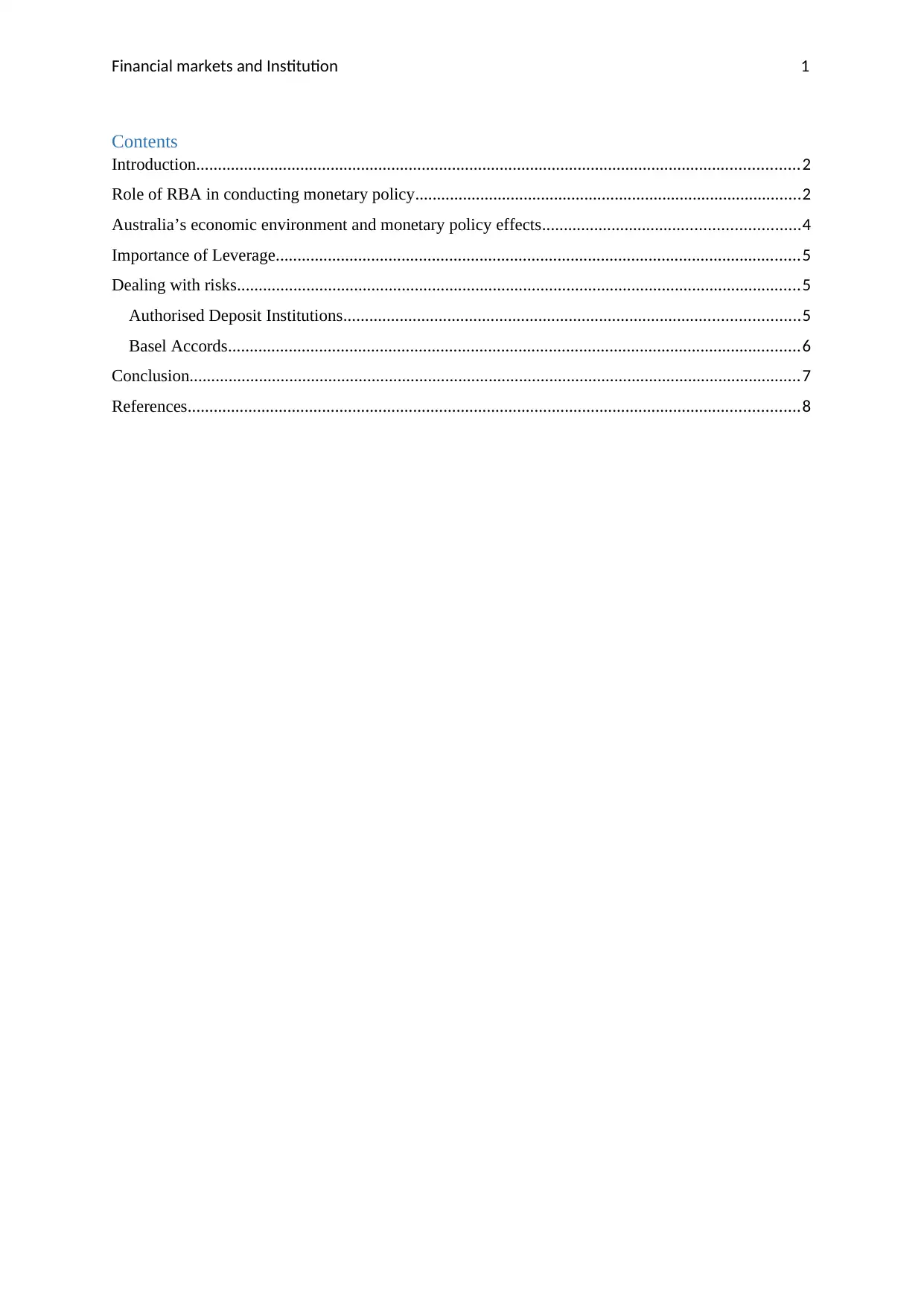
Financial markets and Institution 1
Contents
Introduction...........................................................................................................................................2
Role of RBA in conducting monetary policy.........................................................................................2
Australia’s economic environment and monetary policy effects...........................................................4
Importance of Leverage.........................................................................................................................5
Dealing with risks..................................................................................................................................5
Authorised Deposit Institutions.........................................................................................................5
Basel Accords....................................................................................................................................6
Conclusion.............................................................................................................................................7
References.............................................................................................................................................8
Contents
Introduction...........................................................................................................................................2
Role of RBA in conducting monetary policy.........................................................................................2
Australia’s economic environment and monetary policy effects...........................................................4
Importance of Leverage.........................................................................................................................5
Dealing with risks..................................................................................................................................5
Authorised Deposit Institutions.........................................................................................................5
Basel Accords....................................................................................................................................6
Conclusion.............................................................................................................................................7
References.............................................................................................................................................8
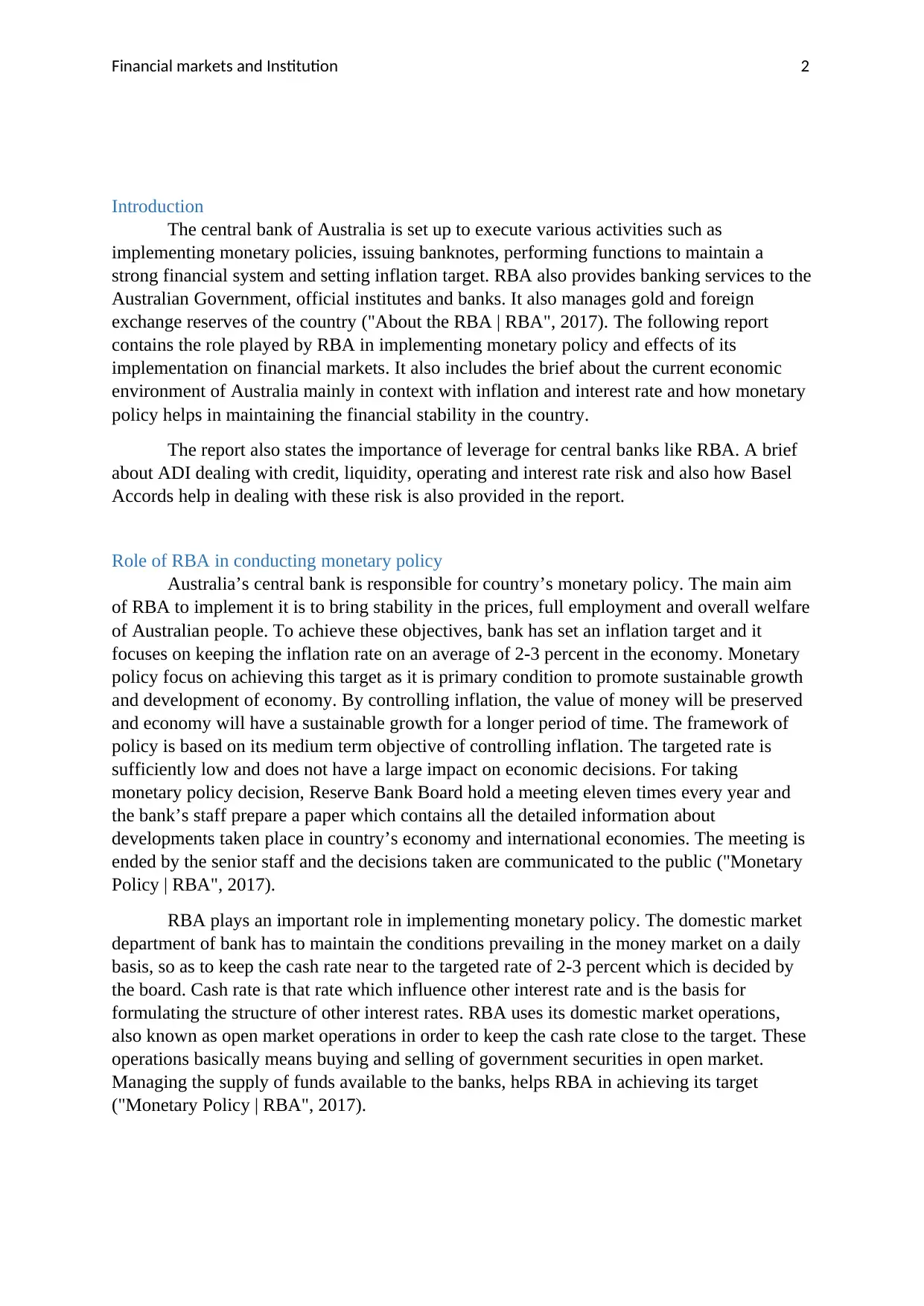
Financial markets and Institution 2
Introduction
The central bank of Australia is set up to execute various activities such as
implementing monetary policies, issuing banknotes, performing functions to maintain a
strong financial system and setting inflation target. RBA also provides banking services to the
Australian Government, official institutes and banks. It also manages gold and foreign
exchange reserves of the country ("About the RBA | RBA", 2017). The following report
contains the role played by RBA in implementing monetary policy and effects of its
implementation on financial markets. It also includes the brief about the current economic
environment of Australia mainly in context with inflation and interest rate and how monetary
policy helps in maintaining the financial stability in the country.
The report also states the importance of leverage for central banks like RBA. A brief
about ADI dealing with credit, liquidity, operating and interest rate risk and also how Basel
Accords help in dealing with these risk is also provided in the report.
Role of RBA in conducting monetary policy
Australia’s central bank is responsible for country’s monetary policy. The main aim
of RBA to implement it is to bring stability in the prices, full employment and overall welfare
of Australian people. To achieve these objectives, bank has set an inflation target and it
focuses on keeping the inflation rate on an average of 2-3 percent in the economy. Monetary
policy focus on achieving this target as it is primary condition to promote sustainable growth
and development of economy. By controlling inflation, the value of money will be preserved
and economy will have a sustainable growth for a longer period of time. The framework of
policy is based on its medium term objective of controlling inflation. The targeted rate is
sufficiently low and does not have a large impact on economic decisions. For taking
monetary policy decision, Reserve Bank Board hold a meeting eleven times every year and
the bank’s staff prepare a paper which contains all the detailed information about
developments taken place in country’s economy and international economies. The meeting is
ended by the senior staff and the decisions taken are communicated to the public ("Monetary
Policy | RBA", 2017).
RBA plays an important role in implementing monetary policy. The domestic market
department of bank has to maintain the conditions prevailing in the money market on a daily
basis, so as to keep the cash rate near to the targeted rate of 2-3 percent which is decided by
the board. Cash rate is that rate which influence other interest rate and is the basis for
formulating the structure of other interest rates. RBA uses its domestic market operations,
also known as open market operations in order to keep the cash rate close to the target. These
operations basically means buying and selling of government securities in open market.
Managing the supply of funds available to the banks, helps RBA in achieving its target
("Monetary Policy | RBA", 2017).
Introduction
The central bank of Australia is set up to execute various activities such as
implementing monetary policies, issuing banknotes, performing functions to maintain a
strong financial system and setting inflation target. RBA also provides banking services to the
Australian Government, official institutes and banks. It also manages gold and foreign
exchange reserves of the country ("About the RBA | RBA", 2017). The following report
contains the role played by RBA in implementing monetary policy and effects of its
implementation on financial markets. It also includes the brief about the current economic
environment of Australia mainly in context with inflation and interest rate and how monetary
policy helps in maintaining the financial stability in the country.
The report also states the importance of leverage for central banks like RBA. A brief
about ADI dealing with credit, liquidity, operating and interest rate risk and also how Basel
Accords help in dealing with these risk is also provided in the report.
Role of RBA in conducting monetary policy
Australia’s central bank is responsible for country’s monetary policy. The main aim
of RBA to implement it is to bring stability in the prices, full employment and overall welfare
of Australian people. To achieve these objectives, bank has set an inflation target and it
focuses on keeping the inflation rate on an average of 2-3 percent in the economy. Monetary
policy focus on achieving this target as it is primary condition to promote sustainable growth
and development of economy. By controlling inflation, the value of money will be preserved
and economy will have a sustainable growth for a longer period of time. The framework of
policy is based on its medium term objective of controlling inflation. The targeted rate is
sufficiently low and does not have a large impact on economic decisions. For taking
monetary policy decision, Reserve Bank Board hold a meeting eleven times every year and
the bank’s staff prepare a paper which contains all the detailed information about
developments taken place in country’s economy and international economies. The meeting is
ended by the senior staff and the decisions taken are communicated to the public ("Monetary
Policy | RBA", 2017).
RBA plays an important role in implementing monetary policy. The domestic market
department of bank has to maintain the conditions prevailing in the money market on a daily
basis, so as to keep the cash rate near to the targeted rate of 2-3 percent which is decided by
the board. Cash rate is that rate which influence other interest rate and is the basis for
formulating the structure of other interest rates. RBA uses its domestic market operations,
also known as open market operations in order to keep the cash rate close to the target. These
operations basically means buying and selling of government securities in open market.
Managing the supply of funds available to the banks, helps RBA in achieving its target
("Monetary Policy | RBA", 2017).
⊘ This is a preview!⊘
Do you want full access?
Subscribe today to unlock all pages.

Trusted by 1+ million students worldwide
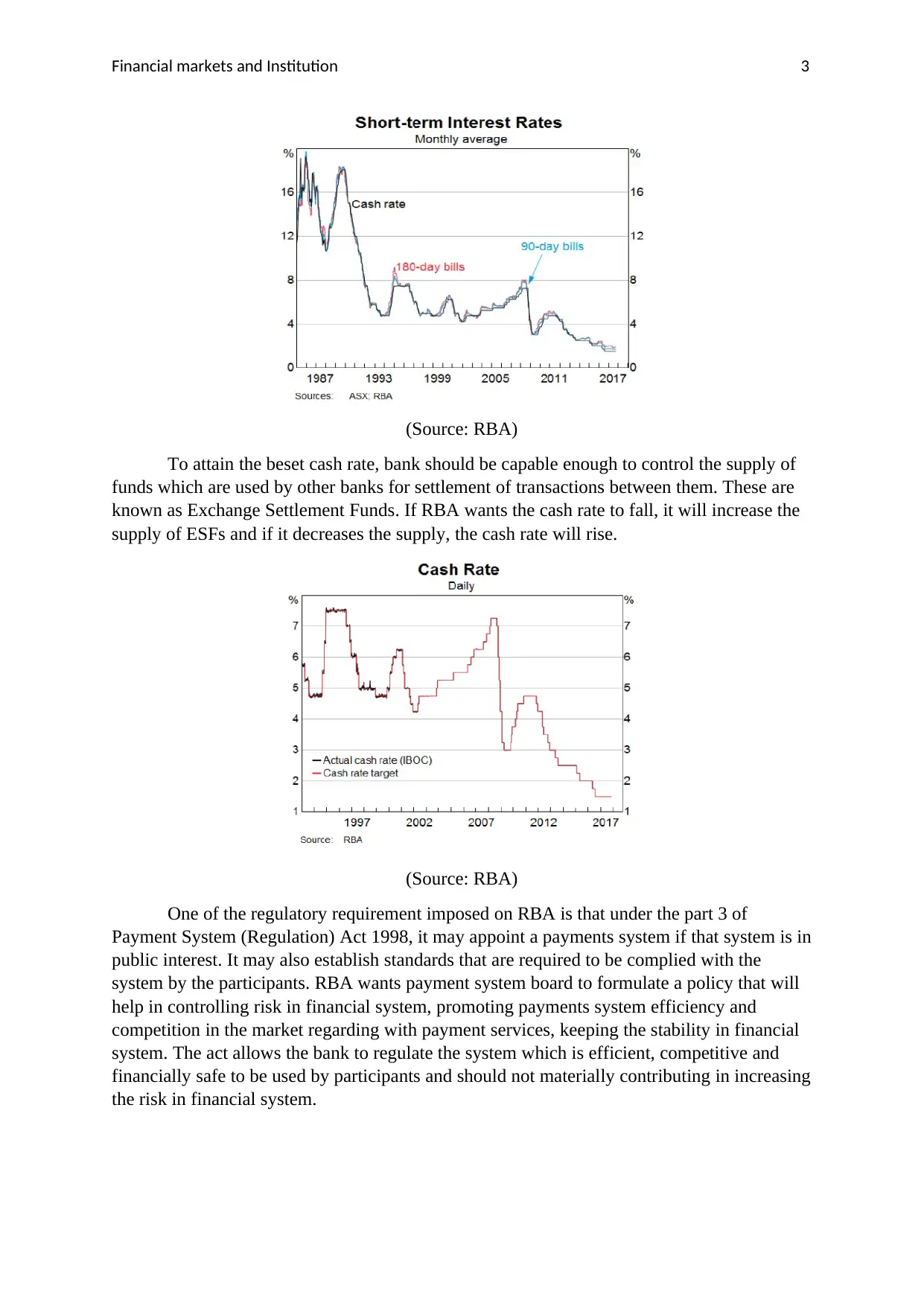
Financial markets and Institution 3
(Source: RBA)
To attain the beset cash rate, bank should be capable enough to control the supply of
funds which are used by other banks for settlement of transactions between them. These are
known as Exchange Settlement Funds. If RBA wants the cash rate to fall, it will increase the
supply of ESFs and if it decreases the supply, the cash rate will rise.
(Source: RBA)
One of the regulatory requirement imposed on RBA is that under the part 3 of
Payment System (Regulation) Act 1998, it may appoint a payments system if that system is in
public interest. It may also establish standards that are required to be complied with the
system by the participants. RBA wants payment system board to formulate a policy that will
help in controlling risk in financial system, promoting payments system efficiency and
competition in the market regarding with payment services, keeping the stability in financial
system. The act allows the bank to regulate the system which is efficient, competitive and
financially safe to be used by participants and should not materially contributing in increasing
the risk in financial system.
(Source: RBA)
To attain the beset cash rate, bank should be capable enough to control the supply of
funds which are used by other banks for settlement of transactions between them. These are
known as Exchange Settlement Funds. If RBA wants the cash rate to fall, it will increase the
supply of ESFs and if it decreases the supply, the cash rate will rise.
(Source: RBA)
One of the regulatory requirement imposed on RBA is that under the part 3 of
Payment System (Regulation) Act 1998, it may appoint a payments system if that system is in
public interest. It may also establish standards that are required to be complied with the
system by the participants. RBA wants payment system board to formulate a policy that will
help in controlling risk in financial system, promoting payments system efficiency and
competition in the market regarding with payment services, keeping the stability in financial
system. The act allows the bank to regulate the system which is efficient, competitive and
financially safe to be used by participants and should not materially contributing in increasing
the risk in financial system.
Paraphrase This Document
Need a fresh take? Get an instant paraphrase of this document with our AI Paraphraser
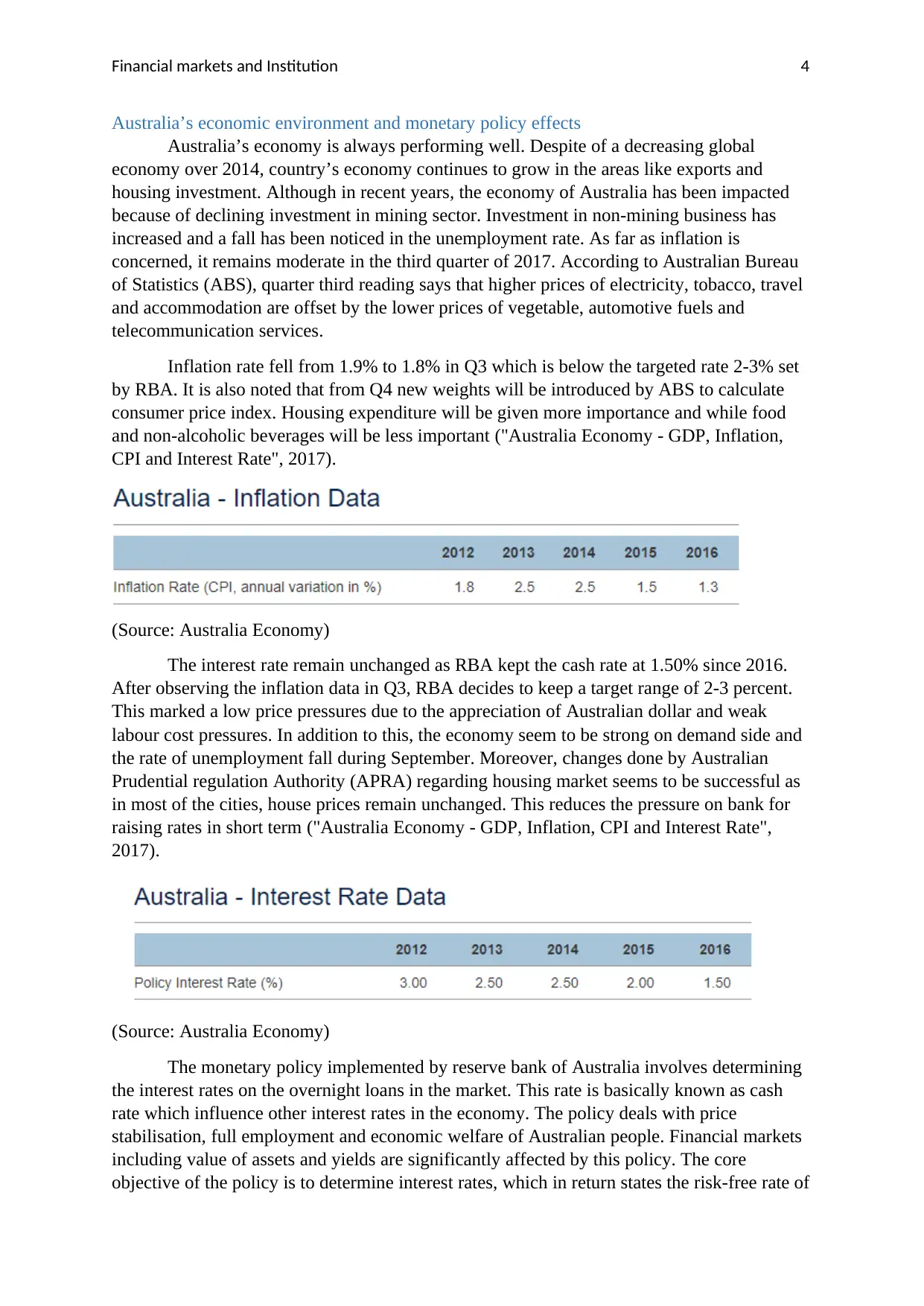
Financial markets and Institution 4
Australia’s economic environment and monetary policy effects
Australia’s economy is always performing well. Despite of a decreasing global
economy over 2014, country’s economy continues to grow in the areas like exports and
housing investment. Although in recent years, the economy of Australia has been impacted
because of declining investment in mining sector. Investment in non-mining business has
increased and a fall has been noticed in the unemployment rate. As far as inflation is
concerned, it remains moderate in the third quarter of 2017. According to Australian Bureau
of Statistics (ABS), quarter third reading says that higher prices of electricity, tobacco, travel
and accommodation are offset by the lower prices of vegetable, automotive fuels and
telecommunication services.
Inflation rate fell from 1.9% to 1.8% in Q3 which is below the targeted rate 2-3% set
by RBA. It is also noted that from Q4 new weights will be introduced by ABS to calculate
consumer price index. Housing expenditure will be given more importance and while food
and non-alcoholic beverages will be less important ("Australia Economy - GDP, Inflation,
CPI and Interest Rate", 2017).
(Source: Australia Economy)
The interest rate remain unchanged as RBA kept the cash rate at 1.50% since 2016.
After observing the inflation data in Q3, RBA decides to keep a target range of 2-3 percent.
This marked a low price pressures due to the appreciation of Australian dollar and weak
labour cost pressures. In addition to this, the economy seem to be strong on demand side and
the rate of unemployment fall during September. Moreover, changes done by Australian
Prudential regulation Authority (APRA) regarding housing market seems to be successful as
in most of the cities, house prices remain unchanged. This reduces the pressure on bank for
raising rates in short term ("Australia Economy - GDP, Inflation, CPI and Interest Rate",
2017).
(Source: Australia Economy)
The monetary policy implemented by reserve bank of Australia involves determining
the interest rates on the overnight loans in the market. This rate is basically known as cash
rate which influence other interest rates in the economy. The policy deals with price
stabilisation, full employment and economic welfare of Australian people. Financial markets
including value of assets and yields are significantly affected by this policy. The core
objective of the policy is to determine interest rates, which in return states the risk-free rate of
Australia’s economic environment and monetary policy effects
Australia’s economy is always performing well. Despite of a decreasing global
economy over 2014, country’s economy continues to grow in the areas like exports and
housing investment. Although in recent years, the economy of Australia has been impacted
because of declining investment in mining sector. Investment in non-mining business has
increased and a fall has been noticed in the unemployment rate. As far as inflation is
concerned, it remains moderate in the third quarter of 2017. According to Australian Bureau
of Statistics (ABS), quarter third reading says that higher prices of electricity, tobacco, travel
and accommodation are offset by the lower prices of vegetable, automotive fuels and
telecommunication services.
Inflation rate fell from 1.9% to 1.8% in Q3 which is below the targeted rate 2-3% set
by RBA. It is also noted that from Q4 new weights will be introduced by ABS to calculate
consumer price index. Housing expenditure will be given more importance and while food
and non-alcoholic beverages will be less important ("Australia Economy - GDP, Inflation,
CPI and Interest Rate", 2017).
(Source: Australia Economy)
The interest rate remain unchanged as RBA kept the cash rate at 1.50% since 2016.
After observing the inflation data in Q3, RBA decides to keep a target range of 2-3 percent.
This marked a low price pressures due to the appreciation of Australian dollar and weak
labour cost pressures. In addition to this, the economy seem to be strong on demand side and
the rate of unemployment fall during September. Moreover, changes done by Australian
Prudential regulation Authority (APRA) regarding housing market seems to be successful as
in most of the cities, house prices remain unchanged. This reduces the pressure on bank for
raising rates in short term ("Australia Economy - GDP, Inflation, CPI and Interest Rate",
2017).
(Source: Australia Economy)
The monetary policy implemented by reserve bank of Australia involves determining
the interest rates on the overnight loans in the market. This rate is basically known as cash
rate which influence other interest rates in the economy. The policy deals with price
stabilisation, full employment and economic welfare of Australian people. Financial markets
including value of assets and yields are significantly affected by this policy. The core
objective of the policy is to determine interest rates, which in return states the risk-free rate of
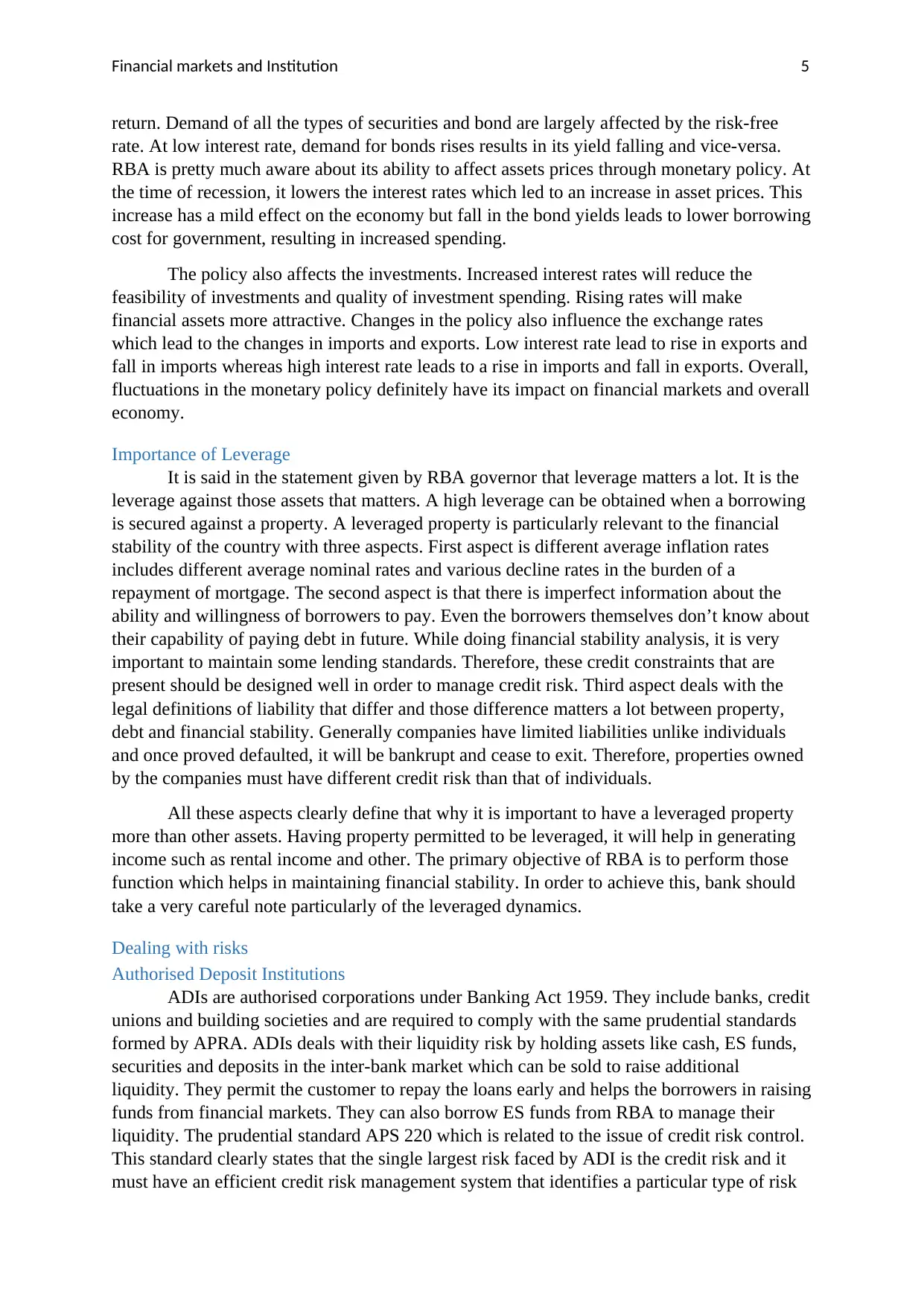
Financial markets and Institution 5
return. Demand of all the types of securities and bond are largely affected by the risk-free
rate. At low interest rate, demand for bonds rises results in its yield falling and vice-versa.
RBA is pretty much aware about its ability to affect assets prices through monetary policy. At
the time of recession, it lowers the interest rates which led to an increase in asset prices. This
increase has a mild effect on the economy but fall in the bond yields leads to lower borrowing
cost for government, resulting in increased spending.
The policy also affects the investments. Increased interest rates will reduce the
feasibility of investments and quality of investment spending. Rising rates will make
financial assets more attractive. Changes in the policy also influence the exchange rates
which lead to the changes in imports and exports. Low interest rate lead to rise in exports and
fall in imports whereas high interest rate leads to a rise in imports and fall in exports. Overall,
fluctuations in the monetary policy definitely have its impact on financial markets and overall
economy.
Importance of Leverage
It is said in the statement given by RBA governor that leverage matters a lot. It is the
leverage against those assets that matters. A high leverage can be obtained when a borrowing
is secured against a property. A leveraged property is particularly relevant to the financial
stability of the country with three aspects. First aspect is different average inflation rates
includes different average nominal rates and various decline rates in the burden of a
repayment of mortgage. The second aspect is that there is imperfect information about the
ability and willingness of borrowers to pay. Even the borrowers themselves don’t know about
their capability of paying debt in future. While doing financial stability analysis, it is very
important to maintain some lending standards. Therefore, these credit constraints that are
present should be designed well in order to manage credit risk. Third aspect deals with the
legal definitions of liability that differ and those difference matters a lot between property,
debt and financial stability. Generally companies have limited liabilities unlike individuals
and once proved defaulted, it will be bankrupt and cease to exit. Therefore, properties owned
by the companies must have different credit risk than that of individuals.
All these aspects clearly define that why it is important to have a leveraged property
more than other assets. Having property permitted to be leveraged, it will help in generating
income such as rental income and other. The primary objective of RBA is to perform those
function which helps in maintaining financial stability. In order to achieve this, bank should
take a very careful note particularly of the leveraged dynamics.
Dealing with risks
Authorised Deposit Institutions
ADIs are authorised corporations under Banking Act 1959. They include banks, credit
unions and building societies and are required to comply with the same prudential standards
formed by APRA. ADIs deals with their liquidity risk by holding assets like cash, ES funds,
securities and deposits in the inter-bank market which can be sold to raise additional
liquidity. They permit the customer to repay the loans early and helps the borrowers in raising
funds from financial markets. They can also borrow ES funds from RBA to manage their
liquidity. The prudential standard APS 220 which is related to the issue of credit risk control.
This standard clearly states that the single largest risk faced by ADI is the credit risk and it
must have an efficient credit risk management system that identifies a particular type of risk
return. Demand of all the types of securities and bond are largely affected by the risk-free
rate. At low interest rate, demand for bonds rises results in its yield falling and vice-versa.
RBA is pretty much aware about its ability to affect assets prices through monetary policy. At
the time of recession, it lowers the interest rates which led to an increase in asset prices. This
increase has a mild effect on the economy but fall in the bond yields leads to lower borrowing
cost for government, resulting in increased spending.
The policy also affects the investments. Increased interest rates will reduce the
feasibility of investments and quality of investment spending. Rising rates will make
financial assets more attractive. Changes in the policy also influence the exchange rates
which lead to the changes in imports and exports. Low interest rate lead to rise in exports and
fall in imports whereas high interest rate leads to a rise in imports and fall in exports. Overall,
fluctuations in the monetary policy definitely have its impact on financial markets and overall
economy.
Importance of Leverage
It is said in the statement given by RBA governor that leverage matters a lot. It is the
leverage against those assets that matters. A high leverage can be obtained when a borrowing
is secured against a property. A leveraged property is particularly relevant to the financial
stability of the country with three aspects. First aspect is different average inflation rates
includes different average nominal rates and various decline rates in the burden of a
repayment of mortgage. The second aspect is that there is imperfect information about the
ability and willingness of borrowers to pay. Even the borrowers themselves don’t know about
their capability of paying debt in future. While doing financial stability analysis, it is very
important to maintain some lending standards. Therefore, these credit constraints that are
present should be designed well in order to manage credit risk. Third aspect deals with the
legal definitions of liability that differ and those difference matters a lot between property,
debt and financial stability. Generally companies have limited liabilities unlike individuals
and once proved defaulted, it will be bankrupt and cease to exit. Therefore, properties owned
by the companies must have different credit risk than that of individuals.
All these aspects clearly define that why it is important to have a leveraged property
more than other assets. Having property permitted to be leveraged, it will help in generating
income such as rental income and other. The primary objective of RBA is to perform those
function which helps in maintaining financial stability. In order to achieve this, bank should
take a very careful note particularly of the leveraged dynamics.
Dealing with risks
Authorised Deposit Institutions
ADIs are authorised corporations under Banking Act 1959. They include banks, credit
unions and building societies and are required to comply with the same prudential standards
formed by APRA. ADIs deals with their liquidity risk by holding assets like cash, ES funds,
securities and deposits in the inter-bank market which can be sold to raise additional
liquidity. They permit the customer to repay the loans early and helps the borrowers in raising
funds from financial markets. They can also borrow ES funds from RBA to manage their
liquidity. The prudential standard APS 220 which is related to the issue of credit risk control.
This standard clearly states that the single largest risk faced by ADI is the credit risk and it
must have an efficient credit risk management system that identifies a particular type of risk
⊘ This is a preview!⊘
Do you want full access?
Subscribe today to unlock all pages.

Trusted by 1+ million students worldwide
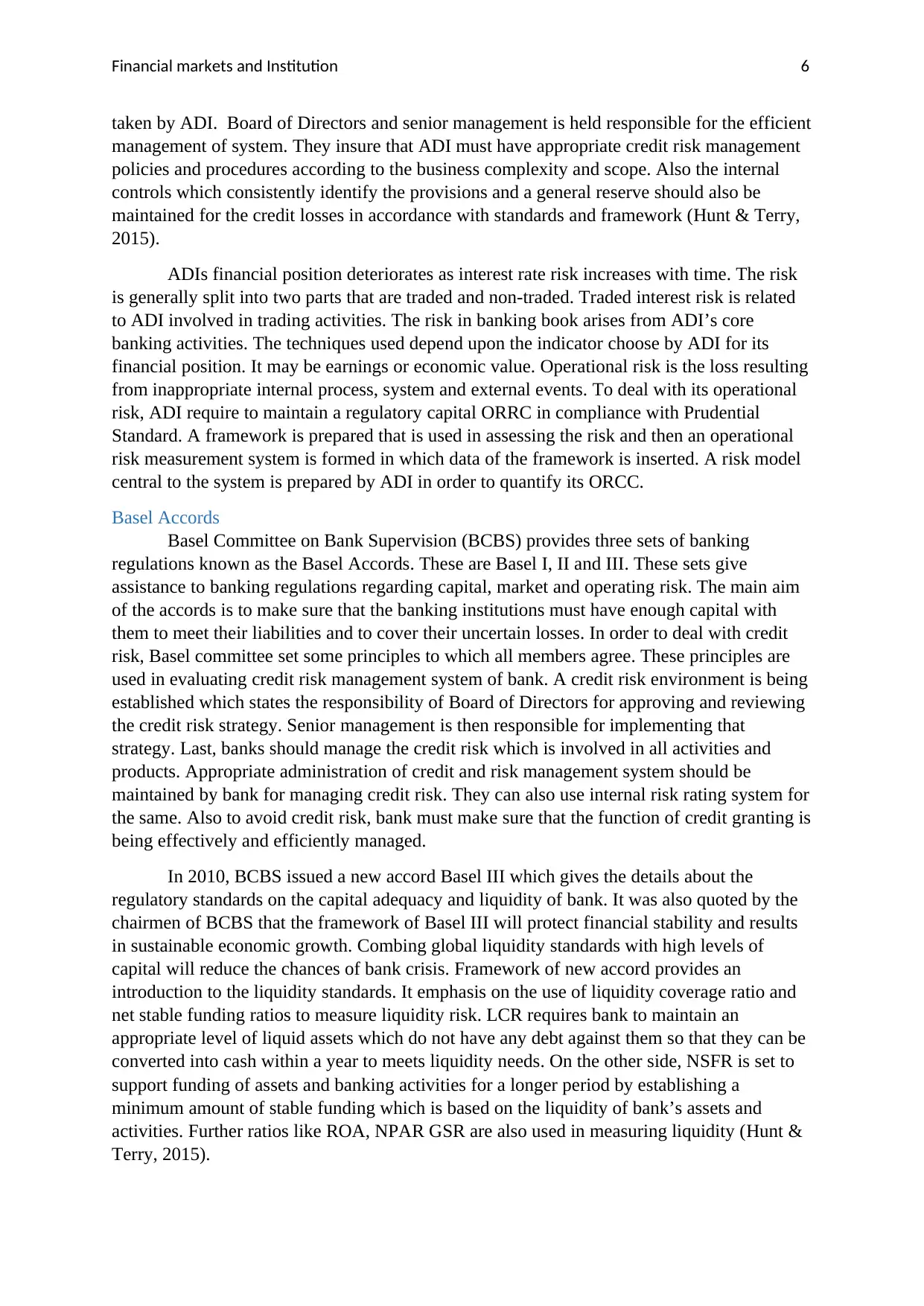
Financial markets and Institution 6
taken by ADI. Board of Directors and senior management is held responsible for the efficient
management of system. They insure that ADI must have appropriate credit risk management
policies and procedures according to the business complexity and scope. Also the internal
controls which consistently identify the provisions and a general reserve should also be
maintained for the credit losses in accordance with standards and framework (Hunt & Terry,
2015).
ADIs financial position deteriorates as interest rate risk increases with time. The risk
is generally split into two parts that are traded and non-traded. Traded interest risk is related
to ADI involved in trading activities. The risk in banking book arises from ADI’s core
banking activities. The techniques used depend upon the indicator choose by ADI for its
financial position. It may be earnings or economic value. Operational risk is the loss resulting
from inappropriate internal process, system and external events. To deal with its operational
risk, ADI require to maintain a regulatory capital ORRC in compliance with Prudential
Standard. A framework is prepared that is used in assessing the risk and then an operational
risk measurement system is formed in which data of the framework is inserted. A risk model
central to the system is prepared by ADI in order to quantify its ORCC.
Basel Accords
Basel Committee on Bank Supervision (BCBS) provides three sets of banking
regulations known as the Basel Accords. These are Basel I, II and III. These sets give
assistance to banking regulations regarding capital, market and operating risk. The main aim
of the accords is to make sure that the banking institutions must have enough capital with
them to meet their liabilities and to cover their uncertain losses. In order to deal with credit
risk, Basel committee set some principles to which all members agree. These principles are
used in evaluating credit risk management system of bank. A credit risk environment is being
established which states the responsibility of Board of Directors for approving and reviewing
the credit risk strategy. Senior management is then responsible for implementing that
strategy. Last, banks should manage the credit risk which is involved in all activities and
products. Appropriate administration of credit and risk management system should be
maintained by bank for managing credit risk. They can also use internal risk rating system for
the same. Also to avoid credit risk, bank must make sure that the function of credit granting is
being effectively and efficiently managed.
In 2010, BCBS issued a new accord Basel III which gives the details about the
regulatory standards on the capital adequacy and liquidity of bank. It was also quoted by the
chairmen of BCBS that the framework of Basel III will protect financial stability and results
in sustainable economic growth. Combing global liquidity standards with high levels of
capital will reduce the chances of bank crisis. Framework of new accord provides an
introduction to the liquidity standards. It emphasis on the use of liquidity coverage ratio and
net stable funding ratios to measure liquidity risk. LCR requires bank to maintain an
appropriate level of liquid assets which do not have any debt against them so that they can be
converted into cash within a year to meets liquidity needs. On the other side, NSFR is set to
support funding of assets and banking activities for a longer period by establishing a
minimum amount of stable funding which is based on the liquidity of bank’s assets and
activities. Further ratios like ROA, NPAR GSR are also used in measuring liquidity (Hunt &
Terry, 2015).
taken by ADI. Board of Directors and senior management is held responsible for the efficient
management of system. They insure that ADI must have appropriate credit risk management
policies and procedures according to the business complexity and scope. Also the internal
controls which consistently identify the provisions and a general reserve should also be
maintained for the credit losses in accordance with standards and framework (Hunt & Terry,
2015).
ADIs financial position deteriorates as interest rate risk increases with time. The risk
is generally split into two parts that are traded and non-traded. Traded interest risk is related
to ADI involved in trading activities. The risk in banking book arises from ADI’s core
banking activities. The techniques used depend upon the indicator choose by ADI for its
financial position. It may be earnings or economic value. Operational risk is the loss resulting
from inappropriate internal process, system and external events. To deal with its operational
risk, ADI require to maintain a regulatory capital ORRC in compliance with Prudential
Standard. A framework is prepared that is used in assessing the risk and then an operational
risk measurement system is formed in which data of the framework is inserted. A risk model
central to the system is prepared by ADI in order to quantify its ORCC.
Basel Accords
Basel Committee on Bank Supervision (BCBS) provides three sets of banking
regulations known as the Basel Accords. These are Basel I, II and III. These sets give
assistance to banking regulations regarding capital, market and operating risk. The main aim
of the accords is to make sure that the banking institutions must have enough capital with
them to meet their liabilities and to cover their uncertain losses. In order to deal with credit
risk, Basel committee set some principles to which all members agree. These principles are
used in evaluating credit risk management system of bank. A credit risk environment is being
established which states the responsibility of Board of Directors for approving and reviewing
the credit risk strategy. Senior management is then responsible for implementing that
strategy. Last, banks should manage the credit risk which is involved in all activities and
products. Appropriate administration of credit and risk management system should be
maintained by bank for managing credit risk. They can also use internal risk rating system for
the same. Also to avoid credit risk, bank must make sure that the function of credit granting is
being effectively and efficiently managed.
In 2010, BCBS issued a new accord Basel III which gives the details about the
regulatory standards on the capital adequacy and liquidity of bank. It was also quoted by the
chairmen of BCBS that the framework of Basel III will protect financial stability and results
in sustainable economic growth. Combing global liquidity standards with high levels of
capital will reduce the chances of bank crisis. Framework of new accord provides an
introduction to the liquidity standards. It emphasis on the use of liquidity coverage ratio and
net stable funding ratios to measure liquidity risk. LCR requires bank to maintain an
appropriate level of liquid assets which do not have any debt against them so that they can be
converted into cash within a year to meets liquidity needs. On the other side, NSFR is set to
support funding of assets and banking activities for a longer period by establishing a
minimum amount of stable funding which is based on the liquidity of bank’s assets and
activities. Further ratios like ROA, NPAR GSR are also used in measuring liquidity (Hunt &
Terry, 2015).
Paraphrase This Document
Need a fresh take? Get an instant paraphrase of this document with our AI Paraphraser
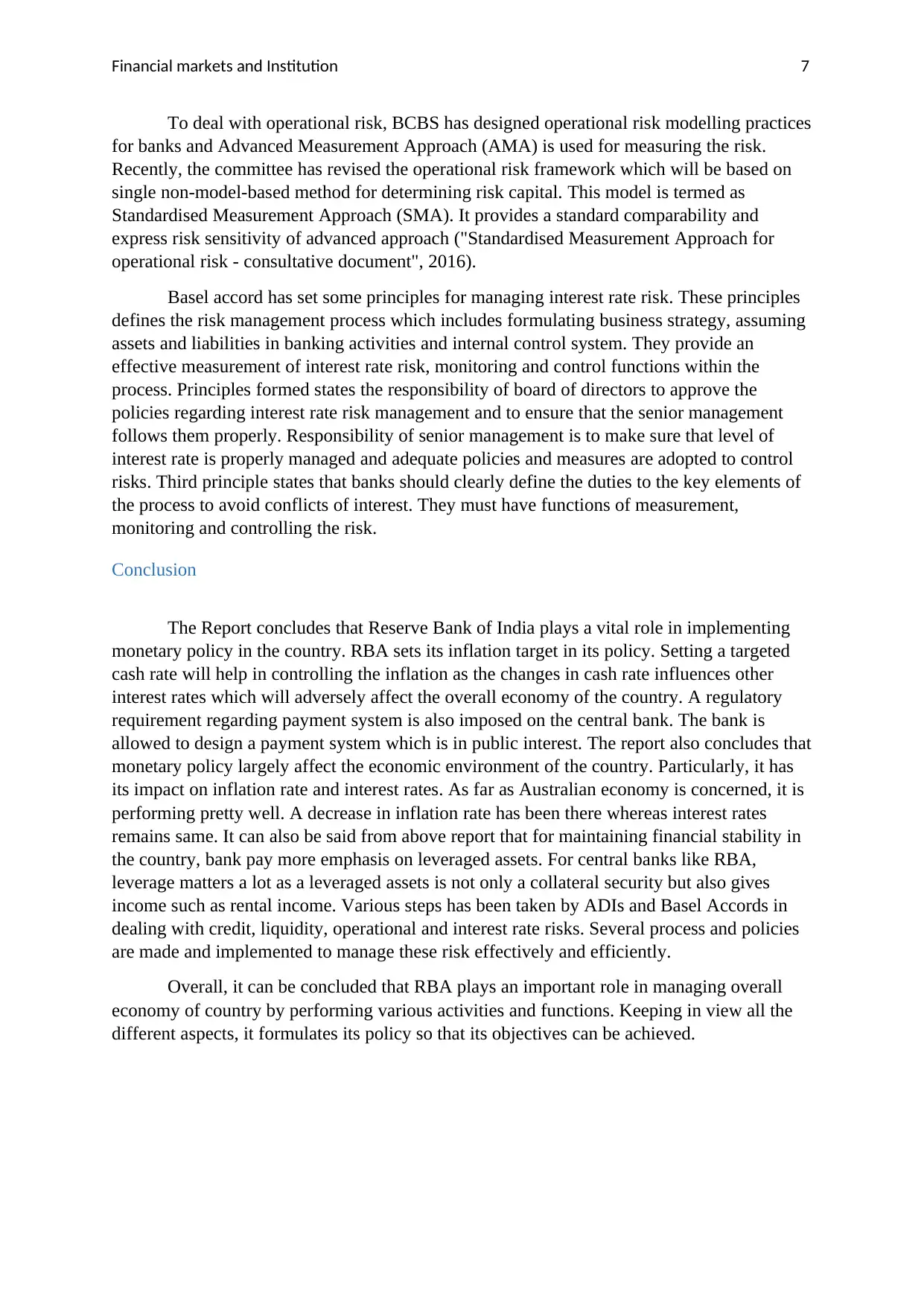
Financial markets and Institution 7
To deal with operational risk, BCBS has designed operational risk modelling practices
for banks and Advanced Measurement Approach (AMA) is used for measuring the risk.
Recently, the committee has revised the operational risk framework which will be based on
single non-model-based method for determining risk capital. This model is termed as
Standardised Measurement Approach (SMA). It provides a standard comparability and
express risk sensitivity of advanced approach ("Standardised Measurement Approach for
operational risk - consultative document", 2016).
Basel accord has set some principles for managing interest rate risk. These principles
defines the risk management process which includes formulating business strategy, assuming
assets and liabilities in banking activities and internal control system. They provide an
effective measurement of interest rate risk, monitoring and control functions within the
process. Principles formed states the responsibility of board of directors to approve the
policies regarding interest rate risk management and to ensure that the senior management
follows them properly. Responsibility of senior management is to make sure that level of
interest rate is properly managed and adequate policies and measures are adopted to control
risks. Third principle states that banks should clearly define the duties to the key elements of
the process to avoid conflicts of interest. They must have functions of measurement,
monitoring and controlling the risk.
Conclusion
The Report concludes that Reserve Bank of India plays a vital role in implementing
monetary policy in the country. RBA sets its inflation target in its policy. Setting a targeted
cash rate will help in controlling the inflation as the changes in cash rate influences other
interest rates which will adversely affect the overall economy of the country. A regulatory
requirement regarding payment system is also imposed on the central bank. The bank is
allowed to design a payment system which is in public interest. The report also concludes that
monetary policy largely affect the economic environment of the country. Particularly, it has
its impact on inflation rate and interest rates. As far as Australian economy is concerned, it is
performing pretty well. A decrease in inflation rate has been there whereas interest rates
remains same. It can also be said from above report that for maintaining financial stability in
the country, bank pay more emphasis on leveraged assets. For central banks like RBA,
leverage matters a lot as a leveraged assets is not only a collateral security but also gives
income such as rental income. Various steps has been taken by ADIs and Basel Accords in
dealing with credit, liquidity, operational and interest rate risks. Several process and policies
are made and implemented to manage these risk effectively and efficiently.
Overall, it can be concluded that RBA plays an important role in managing overall
economy of country by performing various activities and functions. Keeping in view all the
different aspects, it formulates its policy so that its objectives can be achieved.
To deal with operational risk, BCBS has designed operational risk modelling practices
for banks and Advanced Measurement Approach (AMA) is used for measuring the risk.
Recently, the committee has revised the operational risk framework which will be based on
single non-model-based method for determining risk capital. This model is termed as
Standardised Measurement Approach (SMA). It provides a standard comparability and
express risk sensitivity of advanced approach ("Standardised Measurement Approach for
operational risk - consultative document", 2016).
Basel accord has set some principles for managing interest rate risk. These principles
defines the risk management process which includes formulating business strategy, assuming
assets and liabilities in banking activities and internal control system. They provide an
effective measurement of interest rate risk, monitoring and control functions within the
process. Principles formed states the responsibility of board of directors to approve the
policies regarding interest rate risk management and to ensure that the senior management
follows them properly. Responsibility of senior management is to make sure that level of
interest rate is properly managed and adequate policies and measures are adopted to control
risks. Third principle states that banks should clearly define the duties to the key elements of
the process to avoid conflicts of interest. They must have functions of measurement,
monitoring and controlling the risk.
Conclusion
The Report concludes that Reserve Bank of India plays a vital role in implementing
monetary policy in the country. RBA sets its inflation target in its policy. Setting a targeted
cash rate will help in controlling the inflation as the changes in cash rate influences other
interest rates which will adversely affect the overall economy of the country. A regulatory
requirement regarding payment system is also imposed on the central bank. The bank is
allowed to design a payment system which is in public interest. The report also concludes that
monetary policy largely affect the economic environment of the country. Particularly, it has
its impact on inflation rate and interest rates. As far as Australian economy is concerned, it is
performing pretty well. A decrease in inflation rate has been there whereas interest rates
remains same. It can also be said from above report that for maintaining financial stability in
the country, bank pay more emphasis on leveraged assets. For central banks like RBA,
leverage matters a lot as a leveraged assets is not only a collateral security but also gives
income such as rental income. Various steps has been taken by ADIs and Basel Accords in
dealing with credit, liquidity, operational and interest rate risks. Several process and policies
are made and implemented to manage these risk effectively and efficiently.
Overall, it can be concluded that RBA plays an important role in managing overall
economy of country by performing various activities and functions. Keeping in view all the
different aspects, it formulates its policy so that its objectives can be achieved.
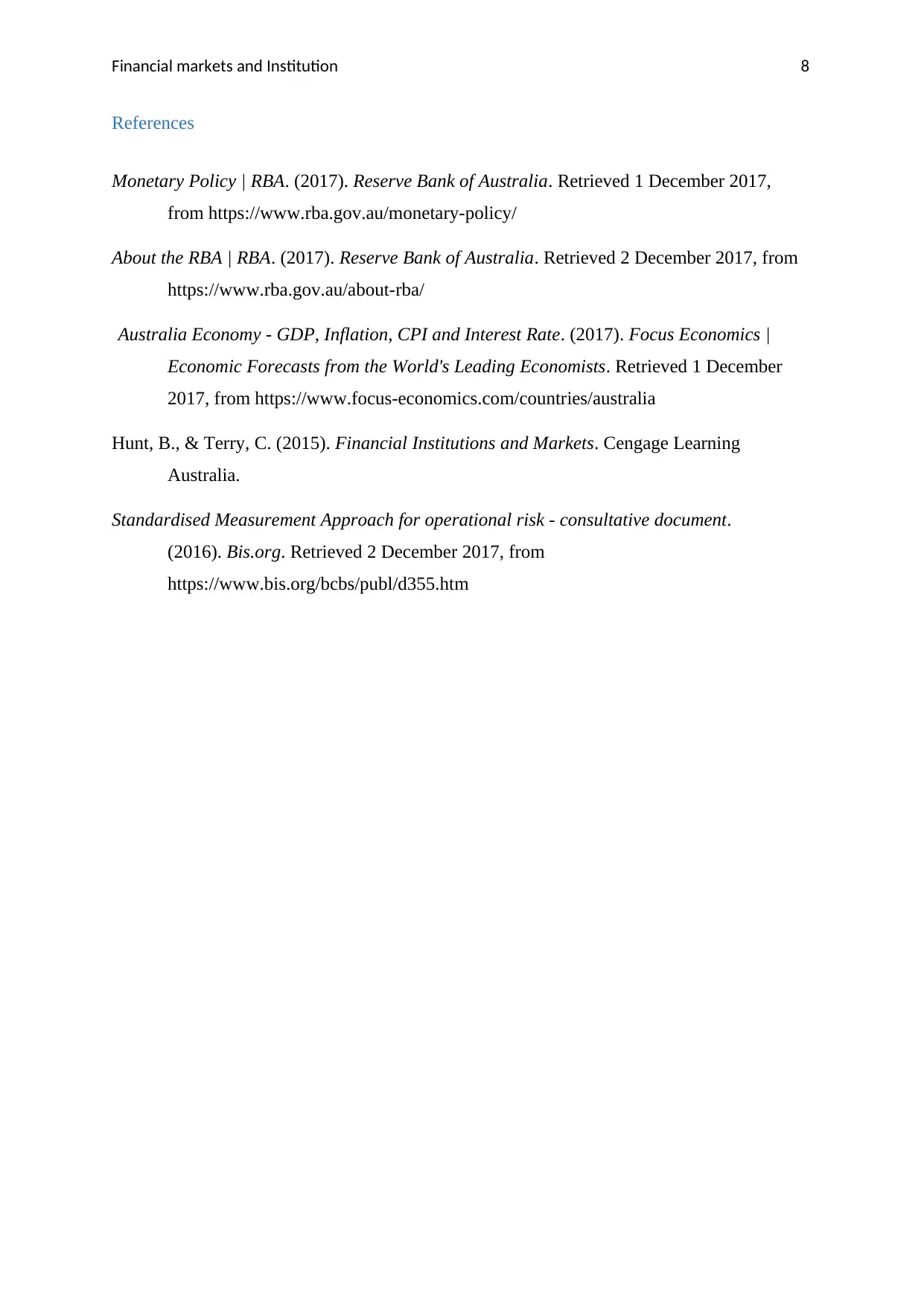
Financial markets and Institution 8
References
Monetary Policy | RBA. (2017). Reserve Bank of Australia. Retrieved 1 December 2017,
from https://www.rba.gov.au/monetary-policy/
About the RBA | RBA. (2017). Reserve Bank of Australia. Retrieved 2 December 2017, from
https://www.rba.gov.au/about-rba/
Australia Economy - GDP, Inflation, CPI and Interest Rate. (2017). Focus Economics |
Economic Forecasts from the World's Leading Economists. Retrieved 1 December
2017, from https://www.focus-economics.com/countries/australia
Hunt, B., & Terry, C. (2015). Financial Institutions and Markets. Cengage Learning
Australia.
Standardised Measurement Approach for operational risk - consultative document.
(2016). Bis.org. Retrieved 2 December 2017, from
https://www.bis.org/bcbs/publ/d355.htm
References
Monetary Policy | RBA. (2017). Reserve Bank of Australia. Retrieved 1 December 2017,
from https://www.rba.gov.au/monetary-policy/
About the RBA | RBA. (2017). Reserve Bank of Australia. Retrieved 2 December 2017, from
https://www.rba.gov.au/about-rba/
Australia Economy - GDP, Inflation, CPI and Interest Rate. (2017). Focus Economics |
Economic Forecasts from the World's Leading Economists. Retrieved 1 December
2017, from https://www.focus-economics.com/countries/australia
Hunt, B., & Terry, C. (2015). Financial Institutions and Markets. Cengage Learning
Australia.
Standardised Measurement Approach for operational risk - consultative document.
(2016). Bis.org. Retrieved 2 December 2017, from
https://www.bis.org/bcbs/publ/d355.htm
⊘ This is a preview!⊘
Do you want full access?
Subscribe today to unlock all pages.

Trusted by 1+ million students worldwide
1 out of 9
Related Documents
Your All-in-One AI-Powered Toolkit for Academic Success.
+13062052269
info@desklib.com
Available 24*7 on WhatsApp / Email
![[object Object]](/_next/static/media/star-bottom.7253800d.svg)
Unlock your academic potential
Copyright © 2020–2025 A2Z Services. All Rights Reserved. Developed and managed by ZUCOL.





